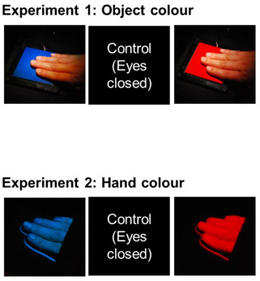Research Abstract
色と温度の相互作用:赤い物体よりも青い物体の方が温かいと判断されやすい
Combining colour and temperature: A blue object is more likely to be judged as warm than a red object
2014年7月3日 Scientific Reports 4 : 5527 doi: 10.1038/srep05527

一般に、赤い色は温かい印象を、青い色は冷たい印象を引き起こすと考えられている。しかし我々は、温度を直接手で触れて感じるときには、逆の関係性があることを示した。実験1では、色の付いた物体に触れたときに「温かい」と感じられる最低の温度を計測した。その結果、青い色の物体の方が、赤い色の物体よりも低い温度で「温かい」と感じられることを示した。実験2では、逆に、物体の色は変化させず、手の色を変化させて、物体に触れたときに「温かい」と感じられる最低の温度を計測した。その結果、効果は逆に、赤い手で触れたときの方が、青い手で触れたときよりも低い温度で「温かい」と感じられた。本研究は、温度を直接手で触れて感じるときに、色が温度の判断を変化させることを初めて示したものである。その作用は、赤が温かく、青が冷たいという一般的な観念に反するものであった。我々はこの現象を、物体に触れる前の視覚的な温度に関する期待と、実際に対象に触れたときの温度の入力とを、両者の対比を強調する形で脳が統合することを示唆する「反ベイズ」統合の観点から解釈した。
何 昕霓1, 岩井 大輔2, 吉川 佑生2, 渡邊 淳司1 & 西田 眞也1
- 日本電信電話株式会社 NTTコミュニケーション科学基礎研究所
- 大阪大学大学院 基礎工学研究科
It is commonly believed that reddish colour induces warm feelings while bluish colour induces cold feelings. We, however, demonstrate an opposite effect when the temperature information is acquired by direct touch. Experiment 1 found that a red object, relative to a blue object, raises the lowest temperature required for an object to feel warm, indicating that a blue object is more likely to be judged as warm than a red object of the same physical temperature. Experiment 2 showed that hand colour also affects temperature judgment, with the direction of the effect opposite to object colours. This study provides the first demonstration that colour can modulate temperature judgments when the temperature information is acquired by direct touch. The effects apparently oppose the common conception of red-hot/blue-cold association. We interpret this phenomenon in terms of “Anti-Bayesian” integration, which suggests that the brain integrates direct temperature input with prior expectations about temperature relationship between object and hand in a way that emphasizes the contrast between the two.

